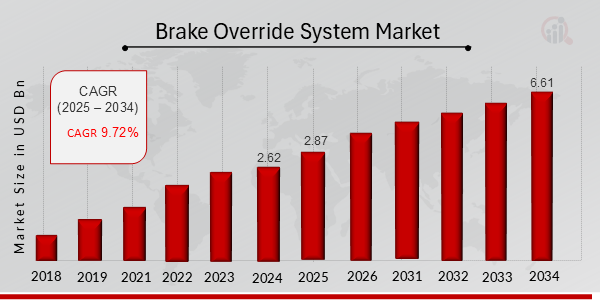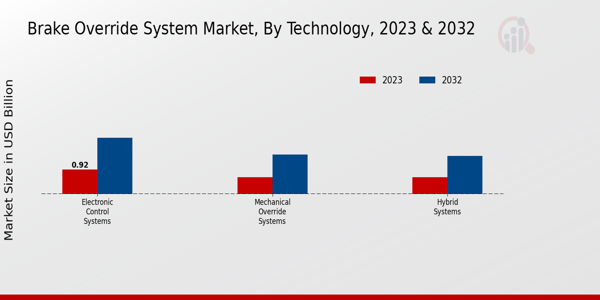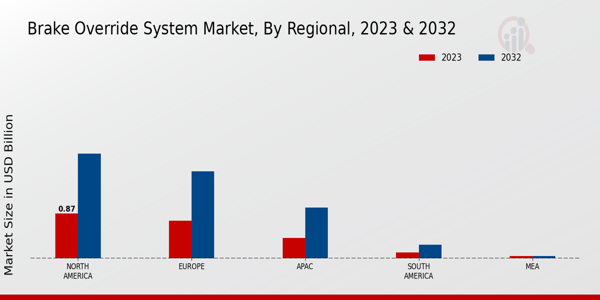Global Brake Override System Market Overview
As per MRFR analysis, the Brake Override System Market Size was estimated at 2.62 (USD Billion) in 2024. The Brake Override System Market Industry is expected to grow from 2.87 (USD Billion) in 2025 to 6.61 (USD Billion) till 2034, at a CAGR (growth rate) is expected to be around 9.72% during the forecast period (2025 - 2034).
Key Brake Override System Market Trends Highlighted
The Brake Override System market is on the rise owing to technology development in automotive systems as well as the growing need for vehicle safety. With an increase in consumer awareness regarding safety functions, manufacturers focus on developing advanced systems integrated in order to avoid unwanted acceleration. This trend towards improving the security of the drivers is an important factor pushing the market forward. The increasing regulations with respect to the safety of the vehicles have made it necessary for the companies to embrace the brake override systems which in turn increases the demand for the market. The market in this space is supremely large, especially for organizations which put money into development.
This includes enhancements in sensor technology, software improvements, and the integration of artificial intelligence to support brake override functionalities. Additionally, as electric and autonomous vehicles gain traction, there are ample chances to develop customized brake solutions that cater to these evolving vehicle types. The global push toward sustainability also opens avenues for eco-friendly brake systems that align with regulations and consumer preferences. Recent trends indicate increasing collaboration between automakers and tech companies to create smarter braking systems. The integration of connected car technologies is influencing the development of brake override systems, enabling better communication between the vehicle and its environment.
Furthermore, consumer preferences are gradually shifting as more drivers prioritize high safety ratings and advanced driver assistance systems when purchasing vehicles. This rising demand drives manufacturers to innovate and implement advanced features that enhance overall vehicle performance while ensuring safety remains a top priority.

Source: Primary Research, Secondary Research, MRFR Database and Analyst Review
Brake Override System Market Drivers
Increased Emphasis on Vehicle Safety Features
The Brake Override System Market is gaining temperature as industries are placing higher importance on features that increase road and vehicle safety, this is because road safety has become a key concern. It can proceed without control from the accelerator, or any control system and brake override systems are designed to prevent accidents related to unintended safety brakes. These innovations are gaining increased attention and popularity especially among vehicle manufacturers as with improved safety standards also comes great consumer responsibility.
Currently, the market of advanced driver assistance systems (ADAS) is developing which enables the brakes override systems market as well. Bringing such systems into the vehicle allows the manufacturer to increase the possibilities for improving the safety characteristics of their cars and the company image as well.
Moreover, as more consumers become aware of their rights to safe driving conditions, there is a collective push for vehicles equipped with modern safety technologies. This trend is expected to significantly drive the expansion of the Brake Override System Market Industry as more automakers incorporate such systems into their designs to instill confidence in their consumers.
Technological Advancements in the Automotive Industry
The Brake Override System Market Industry is being propelled by rapid technological advancements within the automotive sector. With innovations such as artificial intelligence, machine learning, and advanced sensor technologies, vehicle manufacturers are focusing on enhancing the overall driving experience while ensuring enhanced safety. The integration of these advanced technologies in brake override systems not only improves their functionality but also increases their market attractiveness.
As vehicles become increasingly connected and automated, the global automotive industry is pushing towards integrating comprehensive safety features, including brake override systems, into standard vehicle designs. This technological evolution is expected to play a crucial role in elevating the market growth of brake override systems as consumers increasingly demand high-tech, safe driving experiences.
Regulatory Push for Enhanced Safety Standards
The regulatory drive for improved safety standards in the automotive industry is a prominent factor influencing the growth of the Brake Override System Market Industry. Governments and safety organizations worldwide are implementing stricter regulations regarding vehicle performance and safety features. This has resulted in a mandate for manufacturers to equip new vehicle models with advanced safety mechanisms, including brake override systems.
Such regulatory frameworks are vital for standardizing safety measures across vehicles encouraging manufacturers to invest in and adopt cutting-edge technologies. As a result, compliance with these regulations not only enhances consumer trust but also opens up new market opportunities for brake override system manufacturers, contributing significantly to market growth.
Brake Override System Market Segment Insights:
Brake Override System Market Technology Insights
The Brake Override System Market revenue is experiencing significant growth and expansion within the Technology segment, particularly as stakeholders increasingly recognize the importance of safety in automotive applications. In 2023, the overall market is valued at 2.17 USD Billion and is projected to grow to 5.0 USD Billion by 2032, highlighting the robust market dynamics and opportunities present in this industry. The market segmentation reflects three important categories: Electronic Control Systems, Mechanical Override Systems, and Hybrid Systems, each contributing uniquely to the overall growth.
Electronic Control Systems, valued at 0.92 USD Billion in 2023 and projected to reach 2.1 USD Billion by 2032, dominates the segment due to its advanced technological features that enhance vehicle safety and control. Such systems have increasingly become essential in modern vehicles, providing reliability and efficiency that meet regulatory standards and consumer expectations. Mechanical Override Systems, with a current value of 0.63 USD Billion and expected to grow to 1.48 USD Billion, represent another critical part of the market by serving as a fail-safe mechanism, ensuring that systems remain operational in emergency situations.
This sub-segment highlights the necessity of ensuring safety despite technological failures. Lastly, Hybrid Systems, currently valued at 0.62 USD Billion and estimated to reach 1.42 USD Billion, offer a versatile approach by combining electronic and mechanical functionalities, catering to diverse consumer needs and regulatory requirements in the automotive space. Overall, the significance of these categories in the Brake Override System Market statistics illustrates a landscape characterized by technological advancement and an ongoing commitment to enhancing vehicle safety measures, driven by a growing awareness of automotive risks and the continuous evolution of safety policies.
As the market trends towards modernization and automation, these segments are poised to become increasingly relevant, providing ample opportunities for growth and development in technology-focused automotive solutions.

Source: Primary Research, Secondary Research, MRFR Database and Analyst Review
Brake Override System Market Vehicle Type Insights
The Brake Override System Market demonstrates a robust growth trajectory within the Vehicle Type segment, with the entire market expected to reach a valuation of 2.17 USD Billion in 2023 and further escalate in the following years. The segmentation of the market into categories such as Passenger Vehicles, Commercial Vehicles, and Fleet Vehicles indicates a diverse demand landscape. Passenger Vehicles represent a significant portion of this market, driven by increasing consumer safety awareness and the growing adoption of advanced driver-assistance systems (ADAS).
On the other hand, Commercial Vehicles are gaining traction due to stringent regulations aiming to enhance road safety and reduce accidents, thereby enforcing the integration of brake override systems to meet compliance. Meanwhile, Fleet Vehicles also dominate in this context, as companies are prioritizing fleet safety and efficiency, creating a substantial opportunity for market growth. The emphasis on safety features across all vehicle types contributes to the rising demand, reiterating the importance of the Brake Override System Market as it continues to evolve with innovative technologies and regulatory changes, improving overall road safety.
Brake Override System Market Application Insights
The Brake Override System Market, valued at 2.17 USD Billion in 2023, encompasses various applications contributing to its growth trajectory. Within this landscape, the focus on safety systems is critical, as they enhance vehicle safety protocols and reduce accident rates, drawing significant interest from regulatory authorities and consumer safety advocates alike. The Autonomous Driving segment is gaining momentum as technological advancements drive demand for brake override systems that ensure vehicle control during automated driving, addressing safety concerns in the sector.
Fleet Management also plays a crucial role, with fleet operators increasingly adopting brake override technologies to optimize their operational safety and vehicle performance. Together, these applications underscore the importance of the Brake Override System Market, reflecting strong market growth supported by evolving automotive technology, increasing safety regulations, and a growing emphasis on vehicle automation. This dynamic environment highlights the need for continuous innovation, creating opportunities for stakeholders to capitalize on emerging trends in the market.
Brake Override System Market End Use Insights
The Brake Override System Market, valued at 2.17 USD Billion in 2023, showcases a significant segmentation by End Use, comprising Personal Use, Corporate Fleets, and Public Transportation. Personal Use represents a vital segment, reflecting the growing consumer focus on vehicle safety features, which drives the adoption of brake override systems. Corporate Fleets, often prioritized for safety and liability, significantly influence the market's growth due to regulations and company policies advocating advanced safety technologies in commercial vehicles.
Public Transportation dominates as governments increasingly invest in safety for mass transit systems, making it essential for minimizing accidents and enhancing passenger confidence. These developments contribute substantively to the Brake Override System Market revenue, highlighting trends toward safety and regulatory compliance. Market growth is fostered by technological advancements and increased awareness of road safety, though challenges remain in cost management and technological integration across diverse vehicle types.
The Brake Override System Market data indicates that strategic advancements and investment in these segments may further propel the market forward, aligning with global safety initiatives.
Brake Override System Market Regional Insights
The Brake Override System Market is experiencing notable growth, with the market expected to be valued at 2.17 USD Billion in 2023 and projected to rise significantly by 2032. In this context, the Regional segmentation reveals interesting insights. North America is a leading market, holding a valuation of 0.87 USD Billion in 2023 and expected to reach 2.02 USD Billion by 2032, indicating its majority holding in the overall market due to advanced automotive technologies and strict safety regulations. Europe closely follows, valued at 0.73 USD Billion in 2023, with a projection of 1.68 USD Billion, emphasizing its important role driven by high awareness of safety standards.
The Asia-Pacific (APAC) region, although valued lower at 0.4 USD Billion, is expected to grow to 0.98 USD Billion by 2032, reflecting rapidly increasing vehicle production and demand for safety features. South America, valued at 0.12 USD Billion in 2023 and projected to grow to 0.27 USD Billion, demonstrates potential growth due to evolving automotive markets. The Middle East and Africa (MEA) remain less dominant, holding a steady value of 0.05 USD Billion throughout this period, indicating slower market advancements. Overall, the Brake Override System Market segmentation showcases varied growth trajectories and highlights North America's dominance as a key player in this industry.

Source: Primary Research, Secondary Research, MRFR Database and Analyst Review
Brake Override System Market Key Players and Competitive Insights:
The Brake Override System Market is becoming increasingly significant in the automotive industry, providing essential safety and control features that enhance vehicle performance. With the rise in advanced driver-assistance systems (ADAS), the demand for brake override systems is on the rise, positioning these technologies as critical components for both passenger and commercial vehicles. Market competition is being shaped by various factors, including technological advancements, partnerships, and strategic developments aimed at improving the effectiveness and reliability of these systems. As vehicle manufacturers focus more on safety and regulatory compliance, the landscape for brake override systems is evolving, with numerous players aiming to capture a substantial market share by offering innovative solutions that meet the diverse needs of consumers and automotive manufacturers alike.
ZF Friedrichshafen has established a strong presence in the Brake Override System Market by leveraging its expertise in vehicle safety technology and engineering. The company's strengths include a well-established reputation for quality, innovation, and reliability in automotive components. ZF Friedrichshafen excels in providing advanced braking solutions that integrate seamlessly into a wide range of vehicle platforms. Their commitment to research and development allows the company to stay ahead of technological trends and adapt to new safety regulations. Moreover, ZF's ability to build strategic alliances with automakers enhances its market competitiveness, ensuring its brake override systems align with the latest advancements in vehicle technology. This competitive edge positions ZF Friedrichshafen as a key player in the ongoing evolution of braking safety systems.
Denso is another influential player in the Brake Override System Market, distinguished by its comprehensive approach to automotive technology and its commitment to enhancing vehicle control and safety. The company emphasizes technological innovation in designing systems that not only meet regulatory requirements but also significantly improve vehicle user experience. Denso's strengths lie in its robust supply chain network and its ability to implement cutting-edge technology across different vehicle models. Leveraging its extensive experience in automotive electronics, Denso develops brake override systems that are characterized by their integration with intelligent driver-assistance features. The company’s dedication to sustainability and safety on the road further enhances its position in the market, as it continuously seeks to provide solutions that meet growing consumer expectations for both performance and environmental responsibility.
Key Companies in the Brake Override System Market Include:
- ZF Friedrichshafen
- Denso
- Mando Corporation
- TMD Friction
- TRW Automotive
- Continental AG
- Honeywell
- Robert Bosch
- WABCO
- Kongsberg Automotive
- Aisin Seiki
- Haldex
- Bendix Commercial Vehicle Systems
- Schaeffler
- Smiths Group
Brake Override System Industry Developments
Recent developments in the Brake Override System Market include an increased focus on safety regulations that mandate the implementation of advanced braking systems, prompting automakers to integrate these technologies in their new vehicle models. The market has been witnessing notable partnerships and collaborations among key players like ZF Friedrichshafen and Denso, which aim to innovate and enhance braking performance. Companies like Mando Corporation and Honeywell are reporting significant growth in their market valuation, reflecting heightened demand for brake override systems in both passenger and commercial vehicles. Furthermore, the rise in electric vehicle production has spurred interest among manufacturers, as systems such as those produced by Continental AG and TMD Friction are being adapted for electric models. In terms of mergers and acquisitions, recent activity has seen TRW Automotive and Robert Bosch engaging in strategic partnerships to expand their technology portfolios. Market growth is expected to be driven by the evolving automotive landscape and advancements in sensor technologies, along with increasing consumer awareness regarding vehicle safety. The ongoing emphasis on regulatory compliance continues to shape the market dynamics as manufacturers strive to keep pace with new safety standards.
Brake Override System Market Segmentation Insights
Brake Override System Market Technology Outlook
- Electronic Control Systems
- Mechanical Override Systems
- Hybrid Systems
Brake Override System Market Vehicle Type Outlook
- Passenger Vehicles
- Commercial Vehicles
- Fleet Vehicles
Brake Override System Market Application Outlook
- Safety Systems
- Autonomous Driving
- Fleet Management
Brake Override System Market End Use Outlook
- Personal Use
- Corporate Fleets
- Public Transportation
Brake Override System Market Regional Outlook
- North America
- Europe
- South America
- Asia Pacific
- Middle East and Africa
| Report Attribute/Metric |
Details |
|
Market Size 2024
|
2.62 (USD Billion)
|
|
Market Size 2025
|
2.87 (USD Billion)
|
|
Market Size 2034
|
6.61 (USD Billion)
|
|
Compound Annual Growth Rate (CAGR)
|
9.72% (2025 - 2034)
|
|
Report Coverage
|
Revenue Forecast, Competitive Landscape, Growth Factors, and Trends
|
|
Base Year
|
2024
|
|
Market Forecast Period
|
2025 - 2034
|
|
Historical Data
|
2019 - 2023
|
| Market Forecast Units |
USD Billion |
| Key Companies Profiled |
ZF Friedrichshafen, Denso, Mando Corporation, TMD Friction, TRW Automotive, Continental AG, Honeywell, Robert Bosch, WABCO, Kongsberg Automotive, Aisin Seiki, Haldex, Bendix Commercial Vehicle Systems, Schaeffler, Smiths Group |
| Segments Covered |
Technology, Vehicle Type, Application, End Use, Regional |
| Key Market Opportunities |
Technological advancements in automation, Rising demand for vehicle safety, Expansion of electric and hybrid vehicles, Regulatory compliance and standards development, Growing automotive aftermarket services |
| Key Market Dynamics |
Increased vehicle safety regulations, Growing automotive electronic advancements, Rising consumer awareness on of safety, Expansion of autonomous vehicle technology, Demand for advanced driver-assistance systems |
| Countries Covered |
North America, Europe, APAC, South America, MEA |
Frequently Asked Questions (FAQ) :
The Brake Override System Market is expected to reach a value of 6.61 USD Billion by 2034.
The market is projected to grow at a CAGR of 9.7% from 2025 to 2034.
North America is expected to hold the largest market share, projected at 2.02 USD Billion in 2032.
The market for Electronic Control Systems is projected to reach 2.1 USD Billion in 2032.
Major players include ZF Friedrichshafen, Denso, Mando Corporation, and Honeywell.
The market value for Mechanical Override Systems is expected to reach 1.48 USD Billion in 2032.
The market for Hybrid Systems is anticipated to attain a value of 1.42 USD Billion by 2032.
The APAC region is valued at 0.4 USD Billion for the Brake Override System Market in 2023.
The South American market is projected to grow to 0.27 USD Billion by 2032.
Challenges include regulatory hurdles and the high cost of advanced technology implementation.

















